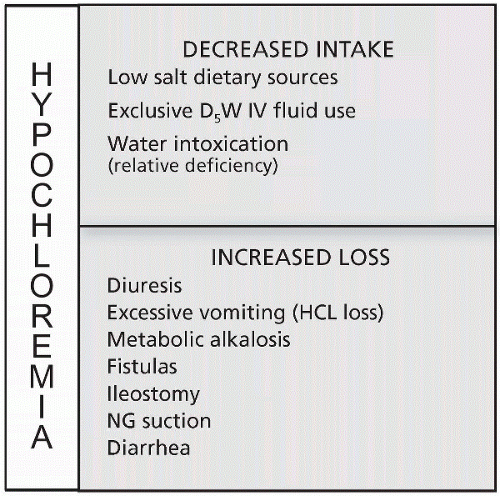Hypochloremia
QUICK LOOK AT THE CHAPTER AHEAD
Hypochloremia is defined as a serum chloride level of less than 98 mEq/L. It rarely occurs in the absence of other abnormalities. It usually occurs along with low serum sodium levels or an elevated serum bicarbonate level. Here we take a look at the causes associated with decreased intake of chloride, increased loss or decreased absorption, as well as manifestations and treatment for this condition.
Hypochloremia is defined as a serum chloride level of less than 98 mEq/L. It usually occurs along with low serum sodium levels or an elevated serum bicarbonate level (metabolic alkalosis).
 Hypochloremia usually occurs along with low serum sodium levels or an elevated serum bicarbonate level.
Hypochloremia usually occurs along with low serum sodium levels or an elevated serum bicarbonate level.Decreased Intake
Increased Loss and Decreased Absorption
An increase in chloride loss contributes to hypochloremia. Chloride is lost through the renal and gastrointestinal systems and through the skin with excessive sweating. Draining fistulas, ileostomies, or prolonged nasogastric suctioning without replacement of chloride can cause a hypochloremic state. Excessive vomiting and diarrhea are situations also related to chloride loss. When hydrochloric acid is lost from the stomach, a situation of metabolic alkalosis can occur due to the fact that there is less competition for the bicarbonate ion with sodium. The loop (Lasix), osmotic (Mannitol), and thiazide (hydrochlorothiazide) diuretics may also bring about a loss of chloride through a decreased absorption of water and electrolytes in the renal system (Table 22-1). All losses contribute to decreased absorption.
Stay updated, free articles. Join our Telegram channel

Full access? Get Clinical Tree




